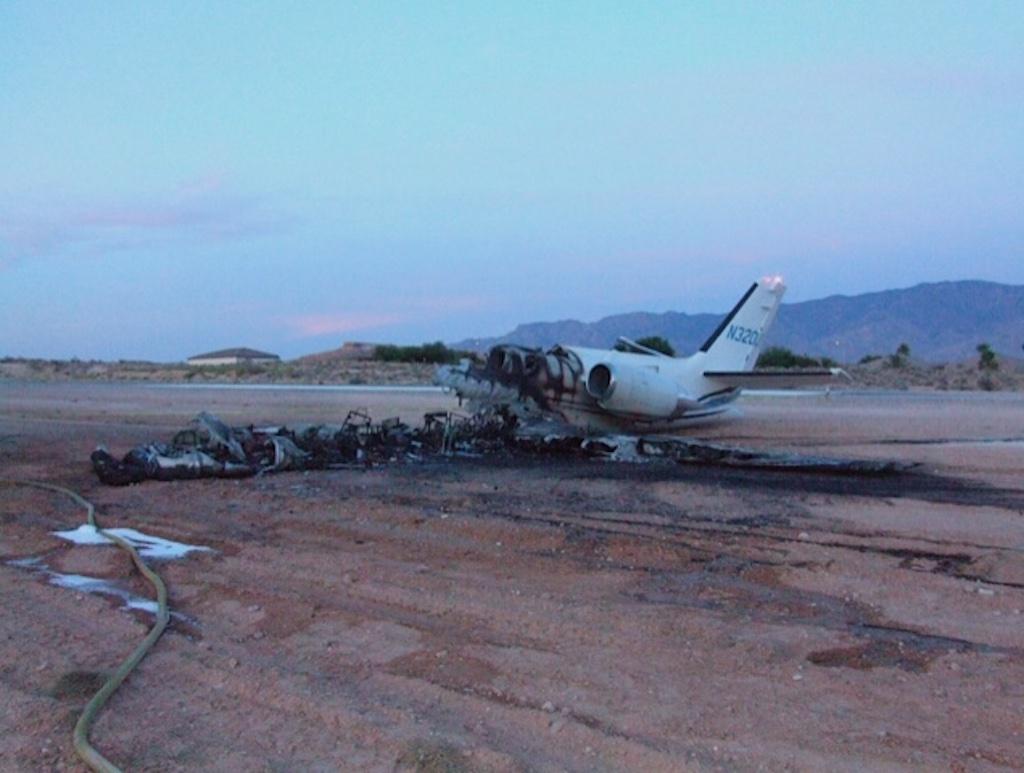
The wreckage of the Cessna 550 Citation at Mesquite Airport.
An FAA Los Angeles Center air traffic controller handling the flight of a Cessna 550 Citation on July 17, 2019, became concerned about the pilot’s health after he began slurring his words and seemed unable to comply with her instructions. The controller’s transmissions and those of the pilot were recorded by FAA and that recording provides a chilling narrative of how extreme alcohol intoxication can affect a pilot’s skills and judgment.
The flight departed Tri-Cities Airport (PSC) near Pasco, Washington, at 16:25 Pacific Standard Time (PST). Its destination was Henderson Executive Airport (HNT) south of Las Vegas. The flight was conducted under instrument flight rules and the pilot later informed the NTSB that it was a Part 91 ferry/positioning flight.
The FAA animated recording shows the flight was cruising at FL350 when the pilot contacted LA Center. The male controller cleared another aircraft to contact Las Vegas Approach on 125.6 at 17:41:39, and this was followed by a garbled reply from an unidentified aircraft. It appears likely that the Citation pilot stepped on the other pilot’s reply and took the descent clearance as being for himself.
The controller then handed off the position to a relief controller, saying “nothing’s happening, no complaints about the ride or anything, and the only traffic, you have.” The new controller was handling numerous other aircraft and issuing several climb and descent clearances, when another muffled transmission occurred at around 18:01:06. The Citation pilot, call sign Jetnet 410, was beginning his descent.
The aircraft’s data block began to show 240 as the cleared altitude. Another controller is heard to say “Jetnet 410 was pretty shabby on his GPS but he’s on a heading of 195.” The pilot then reported, “Amerijet 410 level now at 240.”
Mumbled Responses
The female controller replied, “what’s your call sign?” and he said “Jetnet 410, 240, Citation.” She cleared him down to FL220 and said, “understand you can’t navigate the RNAV arrival, is that correct? After a pause, the pilot said “the airport is in sight, whatever, I’ll take the visual…Whenever it works out, I’ll take the visual,” he repeated, and the controller told him she would pass his request along to Las Vegas Approach, and the handoff would be in about 10 minutes.
“Jetnet 410, fly heading of 220,” she instructed, and the pilot read it back. Then she said, “If you’re able, you’re cleared direct Henderson airport,” and he accepted that clearance. Shortly thereafter, she cleared him to descend to 12,000 ft.
After he made a sharp left turn, the controller said, “Jetnet 410, the heading is 220 and if you can navigate direct Henderson you can do so at this time.” The pilot said, “I’ll make the right turn now.” The reason he turned away from his assigned heading was not clarified.
At 18:13:31, the pilot called again. “Yes, ma’am, sorry, here’s the deal. I’m out of 18 and I feel like I’m still IFR and I want to get down there, you know.” The controller repeated her instruction to descend to 12,000 and said he would still be IFR when he got there. Then the pilot said, “all right, the airport’s in sight, I want to go over there, it’s my business, I’m sure it’s not Los Angeles, and that’s the deal, can I cancel at this point…I’m going to want you guys to keep your present course for VFR flight advisories,” the controller said. The pilot again said, “Absolutely, airport’s in sight, no problem, no problem.” The slurring of his voice was quite noticeable.
“Jetnet 410, are you guys doing okay up there, is there any oxygen issues or anything like that?” the controller asked. After the pilot said, “say again,” she repeated her question, and there was a long pause. His mumbled answer was, “we’re good,” and she said “okay.” She then asked the pilot to verify that he still wanted to go to Henderson airport, and he said “affirm, and I want to descend now.”
At 12,000 ft., the pilot again called the airport in sight and asked to cancel IFR. The controller cleared him to maintain 11,500 ft. Another airplane, a Boeing 737-800, can be seen on the controller’s scope, close behind the Jetnet flight and descending. The Jetnet pilot repeatedly asked to cancel IFR, but from the controller’s point of view, she did not want to risk losing safe separation of the two airplanes.
The Citation turned left toward Mesquite Airport (67L). At 18:25 the pilot again said “cancel IFR, squawking 1200.” The controller said he must stay on the frequency and continue to squawk his assigned code, but he just said “have a great day,” as if he were leaving the frequency. The controller again said to remain on the frequency, then asked if he had another person in the cockpit. What he said sounded like “negative.” When she called again there was no reply.
The pilot made a straight in approach to Runway 20 at Mesquite Airport. A surveillance camera recorded the airplane’s hard landing at 18:44. The main landing gear collapsed and a large fire and dark smoke can be seen coming from the airplane. Multiple impact marks began 2,517 ft. down the 5,121-ft. runway. After the airplane stopped, 50 ft. off the left side of the runway and near its far end, the pilot escaped and the wings and fuselage were consumed by fire.
Airport staff responded to the accident and questioned the pilot, who had been drinking, we report in Part 2 of this article.


